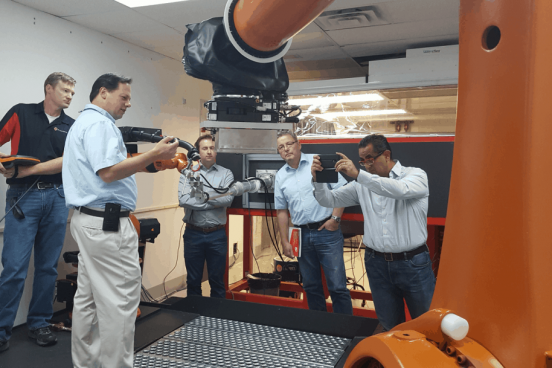Why Laser Peening
Why Laser Peening Leads the Pack in Preventing Metal Fatigue
Talk With Our Laser Peening ExpertsWhy Laser Peening? Because metal fatigue and failure are simply unacceptable.
Laser Peening, often called Laser Shock Peening, can help parts last up to 10 times longer, thanks to a process that delivers precision protection deep into the surfaces of metal components.
The patented Laser Peening process delivers deep protection precisely where you need it to deter corrosion and cracking, optimizing your parts for their mission-critical applications.
See the Proven Advantages
Laser shock peening (LSP) provides deep, precise protection – far more effective than shot peening and other conventional metal improvement processes. The LSP process utilizes short, high-energy laser pulses to deliver component stability in fatigue-prone areas.
- Deeper Protection
- Longer Component Life
- High Temperature Durability
- Precision Modeling and Application
- Production Line Integration
- Flexible Parameters
Applications for Alloys and the Problems We Solve
Longer life for metal parts
LSP Technologies has a wide-ranging library of laser peening prescriptions that have proven effective on a wide range of alloys.
- Titanium alloys
- Aluminum alloys
- Steel
- Stainless Steel
- Nickel alloys
Solving metal fatigue issues
Laser peening can prevent a wide range of metal fatigue symptoms and stop others before they get worse.
- Corrosion
- Cracking
- Fretting
- Foreign Object Damage
- High-cycle Fatigue
- PWSCC
- Cavitation
- Erosion
- Hydrogen Embrittlement
How can laser peening work for you?
View an industry case study and explore the possibilities for metal improvement.
What is Laser Peening?
Laser peening is a cold working metal surface improvement process used to impart compressive residual stresses in a wide-range of materials. Compressive residual stresses induced by laser peening prevents failures from fatigue and other surface deterioration effects by inhibiting crack initiation. Laser peening possesses precise control and the ability to access hard-to-reach areas of a component.
Laser peening can be applied to new and in-service parts. The benefits lead to an increase in service life, extended maintenance intervals, and a reduction in downtime – all without changing the design of the part. Aerospace, power generation, automotive, maritime, heavy equipment, and manufacturing industries can also focus on lightweight components while still maintaining or enhancing metal fatigue strength.
The Importance of Compressive Residual Stress
When determining fatigue strength or damage tolerance of a component, the net stress state is a summation of all existing stress states including applied and residual stresses. As a general rule, most fatigue-prone components fail when they experience high tensile stress or repeated tensile loading concentrated on the part surface. Tensile stresses exacerbate microscopic flaws in the material, pulling tiny cracks apart until they grow into large fissures. When a component is enhanced with compressive residual stresses, it can withstand greater tensile forces before cracking and failure occurs. Stronger compressive residual stresses provide a greater buffer against tensile strain, and deeper compressive stresses inhibit crack initiation and propagation below the surface.
Read more about why compressive residual stresses are key to fatigue life improvement.
Discover More About Laser Peening
Our brochure tells the story of Laser Peening — the process, the benefits, how it prevents metal fatigue, and an introduction to Laser Peening Equipment.
How Laser Peening Works
Laser shock waves penetrate deep into metal surfaces, creating residual stress patterns to counteract corrosion, cracking, and other symptoms of metal fatigue.
How we dial in precise laser peening for alloys and components
Materials experts at LSP Technologies design laser shock peening surface treatments for each part, using variables like the power energy of the laser, length of the laser pulse, and the angle of attack. With controllable parameters, we can prescribe a tailored solution for your potential application. The parameters are all adjustable capabilities of the Procudo® Laser Peening System.
PARAMETERS THAT LSPT CONSIDERS:
Power Density
Depth
Energy
Pulse Width
Spot Size
Angle
Frequency, or Pulse Rate
Spot Pattern
For a deeper dive into the precision and flexibility of laser peening for individual parts, learn more about Laser Peening Parameters.
Frequently Asked Questions
New to Laser Peening?
Find out how Laser Peening can save you time, money, and downtime, adding reliability and safety through precise protection for metal surfaces.
Want to find out more?
Every customer, and every part is different, so we focus on enhancing the safety and reliability of your components.
We begin by understanding your parts, their purpose, and operating conditions.
Then we use computer modeling, as well as our extensive library of industry applications to show how laser peening can meet your needs.
Let us show you how laser peening can extend the operating life of your part by 3-10 times.










